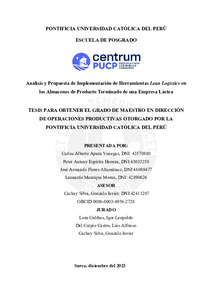| dc.contributor.advisor | Cachay Silva, Gonzalo Javier | |
| dc.contributor.author | Apaza Venegas, Carlos Alberto | |
| dc.contributor.author | Espíritu Herrera, Peter Antony | |
| dc.contributor.author | Flores Altamirano, José Armando | |
| dc.contributor.author | Manrique Moran, Leonardo | |
| dc.date.accessioned | 2024-01-27T16:13:52Z | |
| dc.date.available | 2024-01-27T16:13:52Z | |
| dc.date.created | 2023 | |
| dc.date.issued | 2024-01-27 | |
| dc.identifier.uri | http://hdl.handle.net/20.500.12404/26975 | |
| dc.description.abstract | Se desarrolló la consultoría de negocios en una empresa peruana dedicada a la
fabricación y comercialización de alimentos, principalmente de productos lácteos importantes
para la nutrición de las familias peruanas, cuenta con varios años en el mercado peruano e
internacional. La consultoría se realizó con el objetivo de identificar el problema central en el
área de almacenes de producto terminado, de la unidad de negocios de alimentos, que ha
tenido una serie de reclamos e indicadores no favorables. Se utilizó la metodología del ciclo
de Deming y las herramientas de priorización de causas por factores, matrices de
enfrentamiento, diagrama de Ishikawa y diagrama de Pareto. Se identificaron 17 problemas, y
al realizar el análisis de las causas raíz más importantes se encontraron 21 posibles causas
raíz.
Luego, se aplicaron las herramientas de la metodología Lean Logistics: Evaluación de
Mudas, VSM actual, VSM futuro, 5S, SMED y ANDON en la solución de las causas raíz
encontradas. Como base de la implementación, se propuso que la filosofía sea adoptada en
primera instancia por los puestos gerenciales y ejecutivos, para producir el efecto de cascada,
así como la concientización del personal. Además, se mostraron las posibles mejoras, y se
procedió a realizar una revisión de la madurez de los procesos de la unidad de negocios de
alimentos de la empresa láctea, con el uso de la matriz de Hammer. Posteriormente, se
elaboró el plan de implementación con 36 actividades, y se detalló en el diagrama de Gantt el
tiempo estimado de implementación, que fue de 104 días. De igual manera, se calcularon los
costos asociados de implementación que ascendieron a S/262, 928, los ahorros moderados
que ascendieron a S/16,538 al mes, finalmente se calculó un VAN de S/225, 774 y un
payback de 2.4 años. | es_ES |
| dc.description.abstract | The following executive summary is developed in a company dedicated to
manufacturing and marketing food, primarily dairy products, aiming to bring nutrition to
Peruvian families. It has been in the Peruvian and international markets for several years. The
consultancy objective is to identify the central problem in the finished product warehouse
area of the food business unit, which has had a series of complaints and unfavorable
indicators. For this purpose, it applied the Deming cycle, tools for prioritizing caused by
factors, confrontation matrices, the Ishikawa diagram, and the Pareto diagram. Using the
methodologies and tools shows the main problem. Seventeen problems are the priority, and
the analysis of the main root causes that generate said problems gives a total of 21 root
causes.
Applying then, the tools of Lean Logistics methodology: Mudas Evaluation, current
VSM, future VSM, 5S, SMED, and ANDON in solving the root causes found. For this, as a
basis for the implementation, the cascade effect can be achieved if the management and
executive positions embrace the philosophy in the first instance. As well as raise staff
awareness. A review of the maturity of the processes of the food business unit of the Diary
Company is done after showing the possible improvements, using the Hammer matrix for this
purpose. Preparing 36 activities for the implementation plan and the estimated
implementation time, which was 104 days, was detailed in the Gantt chart. In the same way,
the associated implementation costs are calculated to the amount of S/262,928, and the
moderate savings amounted to S/16,538 per month, calculating an NVP of S/225,774 and a
payback of 2.4 years. | es_ES |
| dc.language.iso | spa | es_ES |
| dc.publisher | Pontificia Universidad Católica del Perú | es_ES |
| dc.rights | info:eu-repo/semantics/openAccess | es_ES |
| dc.rights.uri | http://creativecommons.org/licenses/by-nc-nd/2.5/pe/ | * |
| dc.subject | Logística empresarial--Control de procesos | es_ES |
| dc.subject | Almacenes--Administración--Propuestas de mejora | es_ES |
| dc.subject | Productos lácteos--Perú | es_ES |
| dc.title | Análisis y propuesta de implementación de herramientas Lean Logistics en los almacenes de producto terminado de una empresa láctea | es_ES |
| dc.type | info:eu-repo/semantics/masterThesis | es_ES |
| thesis.degree.name | Maestro en Dirección de Operaciones Productivas | es_ES |
| thesis.degree.level | Maestría | es_ES |
| thesis.degree.grantor | Pontificia Universidad Católica del Perú. CENTRUM | es_ES |
| thesis.degree.discipline | Dirección de Operaciones Productivas | es_ES |
| renati.advisor.dni | 42411207 | |
| renati.advisor.orcid | https://orcid.org/0000-0003-4956-2728 | es_ES |
| renati.author.dni | 43570880 | |
| renati.author.dni | 43033258 | |
| renati.author.dni | 46088477 | |
| renati.author.dni | 42890626 | |
| renati.discipline | 722107 | es_ES |
| renati.juror | Loza Geldres, Igor Leopoldo | es_ES |
| renati.juror | Del Carpio Castro, Luis Alfonso | es_ES |
| renati.juror | Cachay Silva, Gonzalo Javier | es_ES |
| renati.level | https://purl.org/pe-repo/renati/level#maestro | es_ES |
| renati.type | https://purl.org/pe-repo/renati/type#tesis | es_ES |
| dc.publisher.country | PE | es_ES |
| dc.subject.ocde | https://purl.org/pe-repo/ocde/ford#5.02.04 | es_ES |







